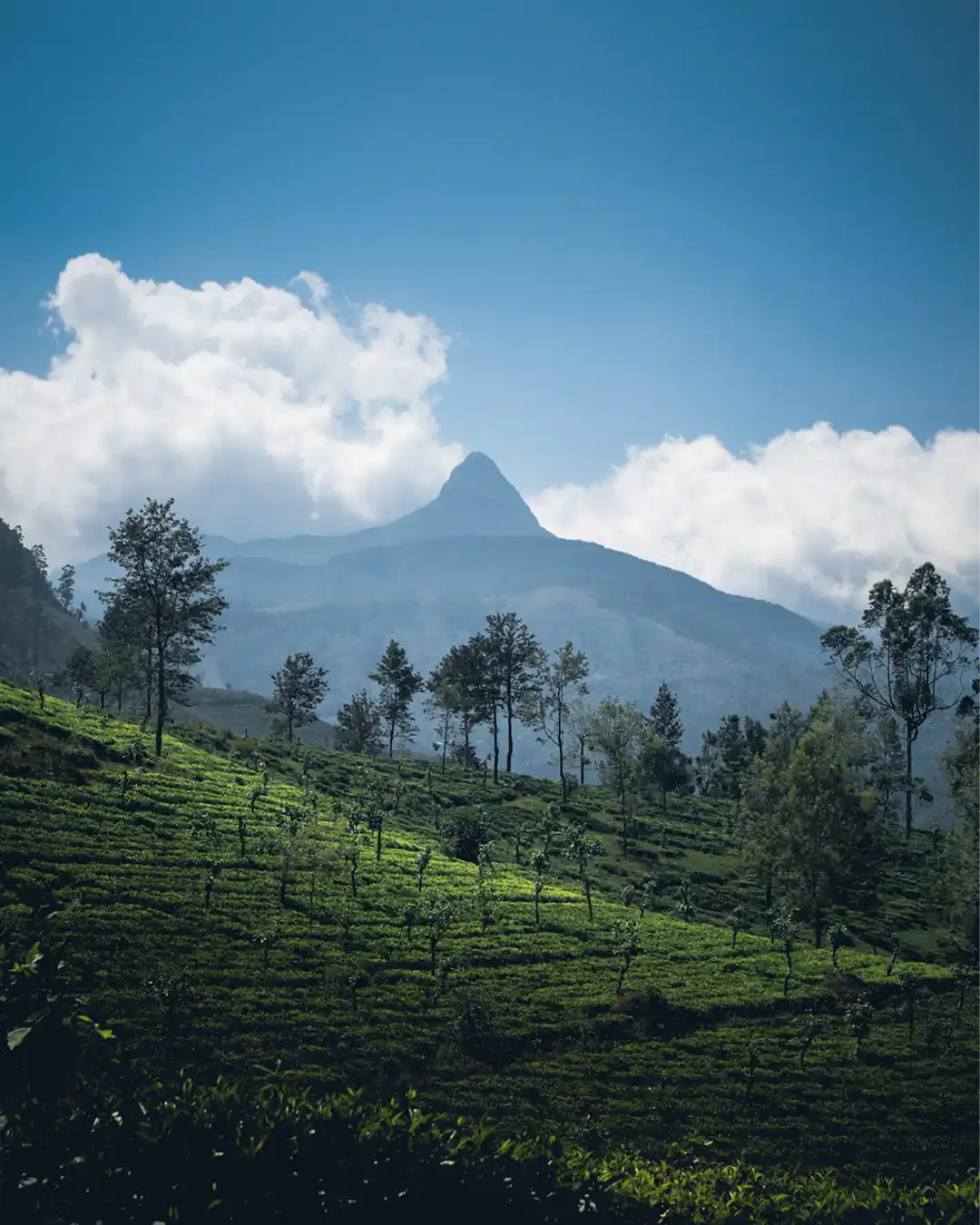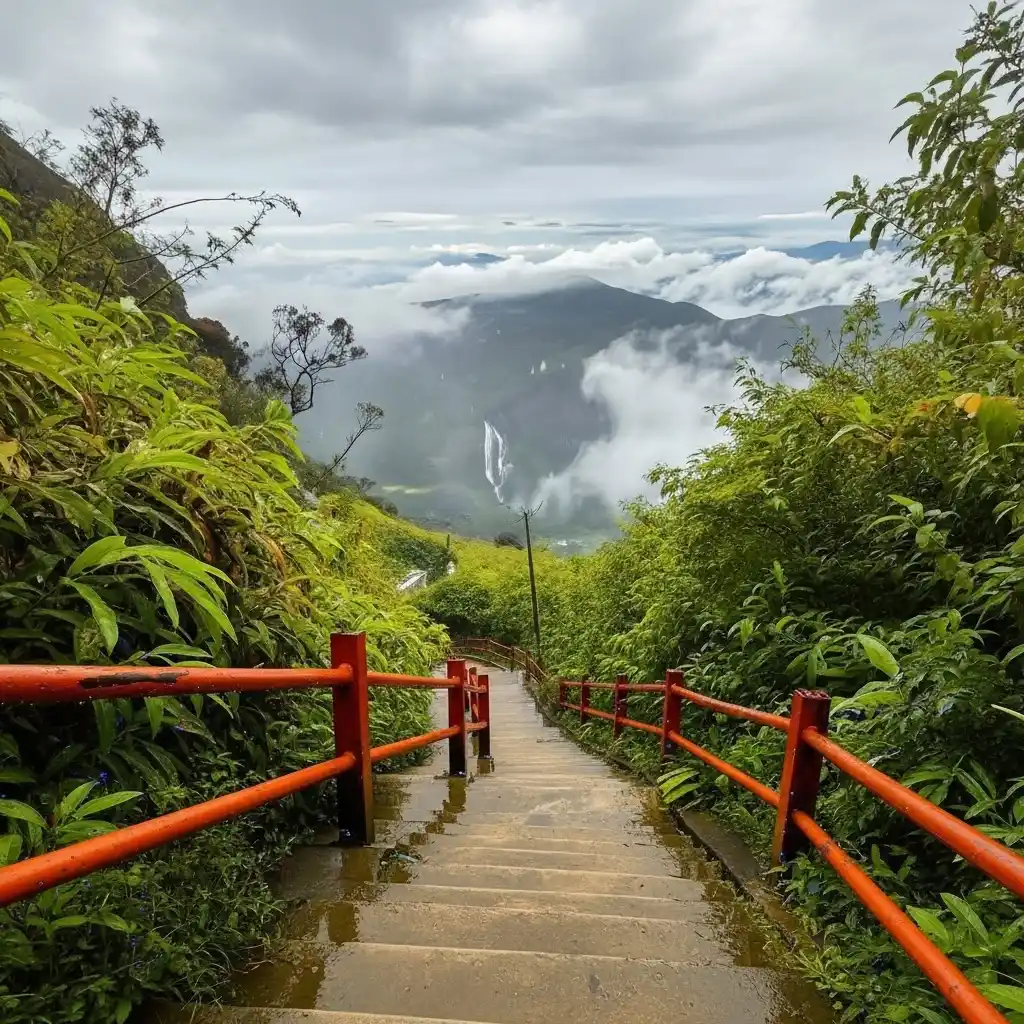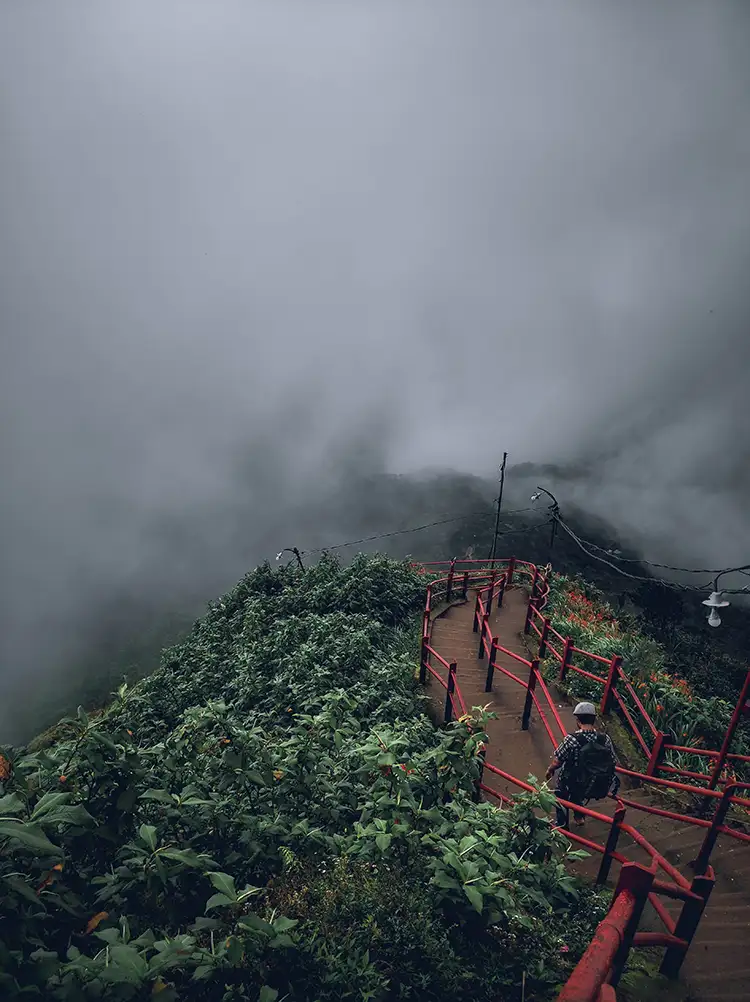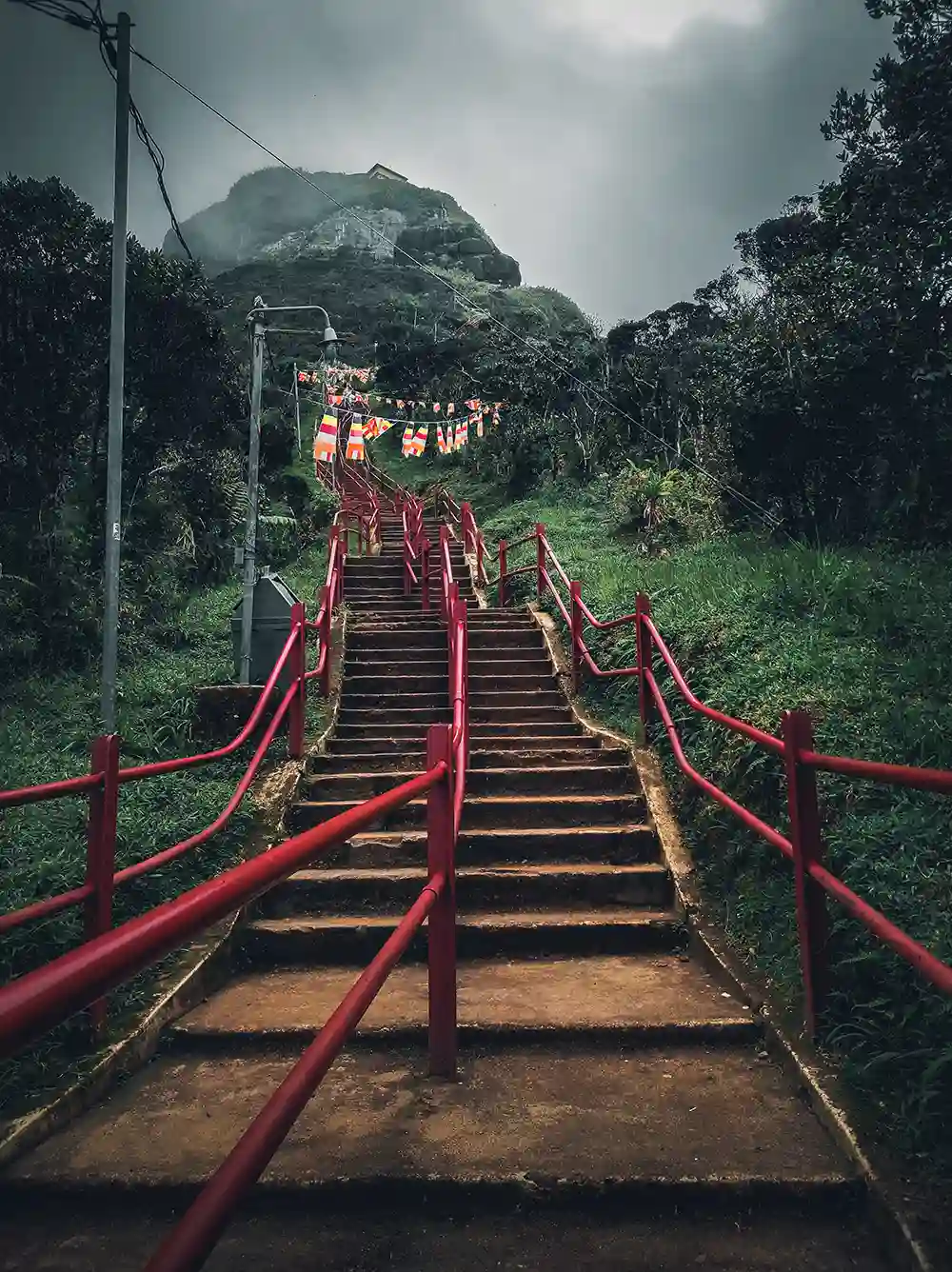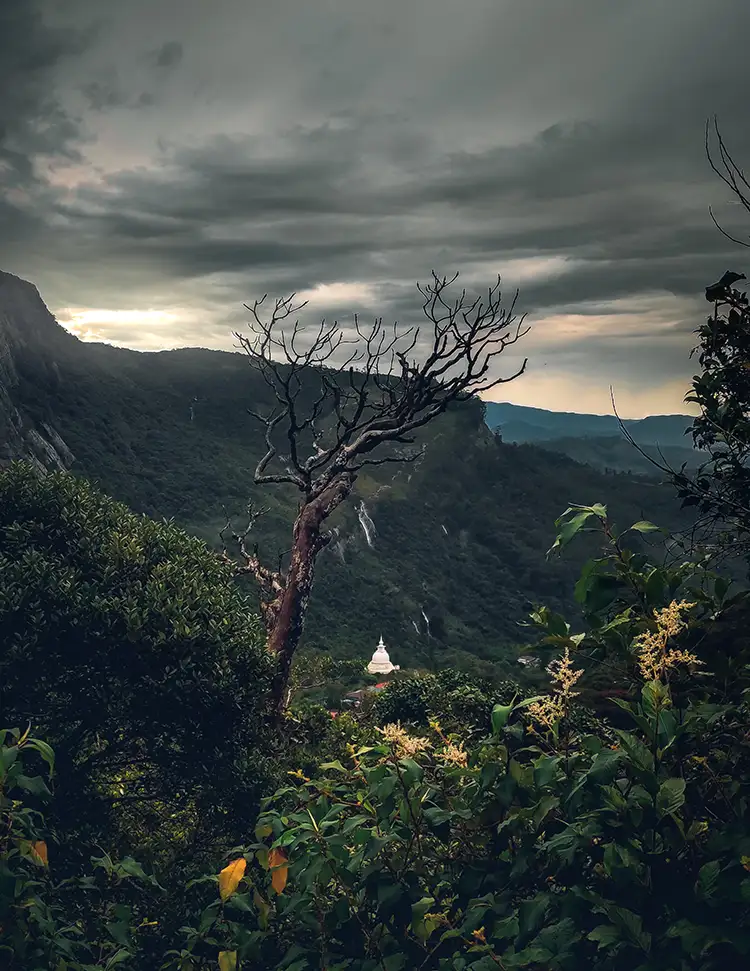Sri Pada / Adam's Peak: Climbing the Sacred Mountain - Complete Guide
 https://res.cloudinary.com/daknktzcc/image/upload/v1761902942/Sri_Pada_Adam_s_Peak_Climbing_the_Sacred_Mountain_gd3p4w.webp?height=600&width=800
https://res.cloudinary.com/daknktzcc/image/upload/v1761902942/Sri_Pada_Adam_s_Peak_Climbing_the_Sacred_Mountain_gd3p4w.webp?height=600&width=800Sri Pada / Adam's Peak: Climbing the Sacred Mountain
Listen, I'm going to be straight with you. When I first heard about climbing a mountain at 2 AM with thousands of barefoot grandmothers who'd absolutely smoke me on the way up, I thought someone was having a laugh. But that's exactly what Sri Pada is. And honestly? It turned into one of those experiences that rewires something in you. The kind of thing you'll be boring your friends about for years.
Adam's Peak, or Sri Pada as the locals call it (which literally translates to "sacred footprint"), isn't just another Instagram-worthy hike. This 2,243-meter beast in Sri Lanka's central highlands has been pulling pilgrims up its slopes for over a thousand years. Buddhists, Hindus, Muslims, Christians. Everyone's got skin in this game, all believing that sacred footprint at the summit belongs to their guy. Buddha. Shiva. Adam. Take your pick.
But here's what nobody tells you in those glossy travel blogs: this climb will absolutely wreck your quads. Your knees will stage a protest. And you'll probably question your life choices somewhere around step 3,000. Yet when that sun breaks over the horizon and you're standing there with a sea of pilgrims chanting, ringing bells, watching that impossibly perfect triangular shadow stretch across the clouds below, none of that matters anymore.
I've tackled my share of mountains, but this one hits different. Maybe it's the energy of 20,000 people climbing on a busy weekend. Maybe it's knowing that kings have been building paths here since the 11th century. Or maybe it's just that combination of spiritual weight and natural beauty that makes Sri Lanka so ridiculously compelling.
What Makes Sri Pada So Bloody Special?
Here's the thing about Adam's Peak. It's only the fifth tallest mountain in Sri Lanka (yeah, surprise), but it punches way above its weight in terms of cultural significance. That footprint shaped rock formation at the summit has been the center of pilgrimage routes for over a millennium.
The pilgrimage season runs from December to May when weather conditions are optimal, and during this time, the mountain transforms into something between a spiritual journey and a very vertical street festival. Tea stalls line the route. Lights illuminate the entire path. Loudspeakers blast devotional music. It's chaos in the most beautiful way possible.
The Sacred Footprint: Who Left It?
The 1.8-meter rock formation at the summit has sparked more debates than a Reddit thread on pineapple pizza. Buddhists claim Buddha left it during his third visit to Sri Lanka. The god Saman supposedly asked for it as a focus of worship, and Buddha obliged. Hindus reckon it's Lord Shiva's calling card. Muslims and Christians? They're convinced it's Adam's footprint, left when he first stepped on Earth after being booted from Eden.
Ancient texts like the Mahavamsa refer to the mountain as Samantakuta, named after a local deity who lived there before Buddhism arrived. The Tamil community calls it Svargarohanam, meaning "the ascent to heaven." The Portuguese dubbed it Pico de Adam, and the British just went with Adam's Peak because, well, they were British.
Honestly, the specific theology matters less than the fact that everyone agrees: this place is special. And when you're up there at dawn, surrounded by people from every corner of the world, every faith, every walk of life, all united in this one shared moment, you get it.
When Should You Actually Do This?
Timing is everything with Sri Pada, and I'm not just talking about what time you start your climb (though we'll get to that nightmare of a decision).
The Pilgrimage Season: December to May
The official season kicks off on the Duruthu poya day (full moon) in December and runs until Vesak poya in May. This is when the mountain puts on its best show. Weather's drier, skies are clearer, and those sunrise views are chef's kiss.
During pilgrimage season, the path becomes a fully lit highway to heaven. Tea shops open all night. You'll find vendors selling everything from warm roti to alarm clocks (because apparently some pilgrims need help waking up at absurd hours). The atmosphere is electric.
But here's the catch: you could be sharing the trail with 20,000 other climbers on a busy weekend. Full moons? School holidays in April? Sri Lankan New Year? Forget about it. The queues can be so long that some people never actually reach the summit. They just get stuck in human traffic somewhere around step 4,500, watching the sunrise from the middle of a very crowded staircase.
Pro tip: If you're climbing during peak season, avoid weekends and public holidays. Weekday climbs, especially early in the season (December through February), offer the sweet spot of good weather without the suffocating crowds.
The Off Season: June to November
Now, some adventurous souls prefer the off season, and I get it. No lights, no tea shops, no crowds, just you, the mountain, and your headlamp. There's something genuinely special about having that trail to yourself, even if it means more rain, heavier mist, and weather that changes its mind faster than a Tinder date.
The silence is profound. The temples at the top feel more intimate. Wildlife sightings go up because the animals aren't hiding from 20,000 stomping pilgrims. But be warned: you'll need proper rain gear, a quality headlamp, and enough water because those convenient trail-side shops? Completely shut.
The Routes: Pick Your Poison
There are technically several routes up Sri Pada, but let's be real, most people take the Hatton route because it's the most developed and, crucially, the shortest.
Hatton Route (via Nallathanniya/Dalhousie)
This is your standard go-to. About 5.5 kilometers long with around 5,500 steps, taking most people 3-5 hours depending on fitness level and how many tea breaks you need. The path is well maintained, fully paved (though "paved" is generous in some sections), and during season, lit up like a Christmas tree.
Getting there is straightforward: reach Hatton by train or bus (the train ride through tea country is gorgeous, by the way), then take a tuk-tuk or bus to Nallathanniya village at the base. The whole journey from Hatton takes about an hour.
The trail starts gently enough. You'll pass the Japanese Peace Pagoda, a serene spot that seems almost ironic given what's about to happen to your legs. Beyond the Peace Pagoda, the steps intensify, becoming increasingly steep as you progress higher. By the time you hit those near-vertical sections with handrails, you're in the final 1,500 steps, and it's a proper leg-wrecker.
Ratnapura Route
This one's for the purists or masochists, depending on your perspective. Much longer at around 10 miles, less steep overall, but taking 8-12 hours. It's quieter, more remote, and offers a genuinely different experience. You'll see fewer people, more wildlife, and have a proper sense of wilderness.
The route winds through the Peak Wilderness Sanctuary, passing through dense cloud forest with moss-covered trees and rare orchids. If you're serious about the pilgrimage aspect or just want to avoid crowds entirely, this is your move. But you'll need to be properly fit and well-prepared.
Other Routes
There's also the Kuruwita route (about 12 miles) and paths from Uva, but these are specialist territory. Unless you're with a guide or genuinely know what you're doing, stick to the main two.
The Night Climb: A Masterclass in Sleep Deprivation
So here's where things get interesting. Most people climb Sri Pada at night, starting anywhere between midnight and 2:30 AM, timing it to reach the summit for sunrise. It sounds romantic until you're actually doing it.
What Time Should You Start?
Sunrise happens between 6:00 and 6:30 AM, and you need to work backward from there based on your fitness level and starting point. Here's my breakdown:
If you're reasonably fit and starting from Nallathanniya: 2:00-2:30 AM is perfect. This gives you 3.5 to 4 hours, plenty of time even with breaks.
If you're less confident about your fitness: Start around midnight or 1:00 AM. Better to arrive early and wait at the summit than miss sunrise stuck in traffic on the steps.
If you're climbing during peak season on a weekend: Honestly? Start at midnight. Maybe earlier. I've heard stories of people starting at 11 PM just to avoid the worst of the crowds. It sounds excessive until you're there.
What's It Actually Like?
Picture this: It's 2 AM. You're half asleep, wondering what possessed you to agree to this. The air is cold enough to see your breath. Then you join this stream of people, all headlamps bobbing in the darkness like a river of fireflies flowing upward.
The first hour is almost meditative. One foot in front of the other. The tea shops provide little oases of light and warmth. You'll hear chanting, see families climbing together, watch elderly folks who are absolutely showing you up on the steps.
Around hour two, reality sets in. Your thighs start sending angry messages. Your knees file a formal complaint. Those steps that seemed manageable are now your nemesis. But here's the beautiful part: everyone's in it together. Strangers encourage each other. People share snacks. There's this unspoken camaraderie that makes the suffering worthwhile.
The final stretch is brutal. Those near-vertical steps with the handrails? They're as bad as everyone says. But then you emerge onto the summit platform, and suddenly you're part of this incredible scene. Hundreds of people huddled together, waiting for dawn, sharing this moment that's been happening for a thousand years.
What You Need to Know Before You Go
Let me give you the practical stuff, the things I wish someone had told me straight up.
Physical Preparation
The climb is rated as moderate difficulty, but that's generous. Yes, technically anyone with reasonable fitness can do it. I've seen children and octogenarians make it to the top. But "can do it" and "will enjoy it" are different things.
Start training a few weeks before. Focus on:
- Stair climbing (obviously)
- Leg strength, especially quads and calves
- Cardio endurance
- Your knees, because the descent is murder on them
Don't go crazy. You're not climbing Everest. But showing up completely unprepared means you'll hate every minute, and that would be a shame.
What to Pack
This is where people either overpack or show up woefully underprepared. Here's the sweet spot:
Essential Gear:
- Headlamp with extra batteries (absolutely critical for off-season)
- Water, at least 1.5-2 liters per person
- Small first aid kit
- Cash in small bills for tea shops, temple offerings, and toilet fees
Clothing:
- Base layer that wicks moisture
- Warm fleece or jacket (it gets properly cold at the summit)
- Light rain jacket, even in season
- Comfortable hiking shoes or good sneakers (I've seen people do it in sandals, but why would you torture yourself?)
- Hat and gloves for the summit wait
Food:
- Energy bars, nuts, fruit
- Something substantial for after sunrise
- Sweets for quick energy
Optional but Recommended:
- Trekking poles (your knees will thank you on the way down)
- Small towel
- Camera (obviously)
- Portable charger
What Not to Bring:
- Your entire backpack from your hostel
- Excessive clothing changes
- Anything valuable you'd be devastated to lose
The Summit Experience: Worth Every Aching Step
Let's talk about why you're actually doing this.
The summit platform is small, crowded, and absolutely magical. At the center sits a shrine housing that famous footprint, protected under a small pavilion. Two bells hang nearby, and tradition dictates pilgrims ring them once for each time they've completed the climb. Some people are on their twentieth ascent, ringing that bell like it's a championship victory.
As dawn approaches, everyone migrates to the east side. The atmosphere shifts from exhausted waiting to electric anticipation. Then the sun breaks the horizon, and I swear, you can feel thousands of people collectively hold their breath.
The Shadow of the Peak
Shortly after sunrise, the mountain casts a perfect triangular shadow onto the clouds below. It's this supernatural sight where Sri Pada's distinctive shape is projected against the morning mist, slowly receding as the sun climbs higher until it vanishes completely.
This phenomenon, called the "Shadow of the Peak," is what pilgrims and photographers dream about. On a clear day, it's one of the most spectacular natural sights you'll witness. On a misty day? Well, you get the spiritual experience without the visual candy, and honestly, that's valuable too.
The 360-Degree Views
If weather cooperates, you're looking at hill country stretching to the east and gentle slopes descending toward the Indian Ocean to the west. On clear mornings, the views encompass the entire central highlands of Sri Lanka, a patchwork of tea plantations, forest reserves, and distant peaks poking through the clouds.
The Descent: Why Nobody Warns You Properly
Here's what every guide glosses over: going down is arguably harder than going up. Those 5,500 steps you climbed in darkness? Now you can see them. Every. Single. One.
Your quads, already protesting from the ascent, are now in full rebellion. Your knees are sending emergency signals. And it takes longer than you'd think, usually 2-3 hours because you're being extra careful not to slip on worn stone steps.
But the descent has its rewards. The cloud forest reveals itself in daylight. The upper slopes host rare montane bird species like the Sri Lanka white-eye and endemic forest species that you completely missed on the way up. The views you couldn't see at night suddenly make sense.
Tea shops that were brief stops on the way up become proper rest stations on the descent. Pro tip: save some cash for a celebratory tea and snack on the way down. You'll have earned it.
Cultural Etiquette and Respect
This isn't just a hike. It's a sacred pilgrimage site, and that matters.
Dress Appropriately
Cover your shoulders and knees, especially near the summit shrine. Yes, it's hot and you're sweating buckets, but respect trumps comfort here. Lightweight, modest clothing exists. Use it.
Temple Behavior
At the summit, remove your shoes before entering the shrine area. Keep voices down. Don't push or shove for photos. If you're not comfortable participating in religious rituals, that's fine, but observe respectfully from the side.
Photography Considerations
Ask before photographing pilgrims in prayer. The summit at dawn is chaotic, but that doesn't give you license to stick cameras in people's faces. Be considerate.
Leave No Trace
Sri Pada sees over 20,000 visitors each season, and unfortunately, litter is a problem. Pack out everything you bring in. Use the designated toilets (yes, they're rough, but that's not an excuse). Don't add to the problem.
Accommodation: Where to Crash
Most people base themselves in either Nallathanniya (Dalhousie) or Hatton, depending on preference and budget.
Nallathanniya/Dalhousie
This tiny village at the base of the trail is super convenient. You can literally walk to the trailhead. Guesthouses range from basic to comfortable, and during season, everything books up fast.
During pilgrimage season, room rates skyrocket and accommodation becomes scarce. Book ahead. Seriously. Don't show up expecting to find something available.
Off-season is different. Rooms can be incredibly cheap, sometimes under 1,000 LKR for a double with private bath. The downside? Fewer amenities, less atmosphere, and you're pretty isolated.
Hatton
Better range of accommodation, more restaurants, easier transport connections. It's about 30 kilometers from the trailhead, roughly an hour by tuk-tuk. You'll need to arrange transport for your pre-dawn departure, but most hotels and guesthouses handle this routinely.
Pro Tip: Book at least two nights of accommodation wherever you stay. Trust me, you're not climbing with your full backpack, and you're definitely not doing anything strenuous the day after. Your legs need recovery time.
Safety Considerations
Adam's Peak is generally safe, but let's not be stupid about it.
Night Climbing Safety
The path is secure and enclosed, so vertigo isn't usually an issue. But it's still a mountain path in darkness. Watch your footing. Use your headlamp. Don't rush.
During peak season, human traffic jams are the bigger concern. People pushing, rushing, trying to squeeze past in narrow sections. Stay calm, stay patient, and don't let the crowd pressure you into unsafe moves.
Health Concerns
Altitude isn't a major issue at 2,243 meters, but some people feel it. Stay hydrated. Eat something even if you're not hungry. If you feel genuinely unwell, there's no shame in turning back.
The descent is where most injuries happen. Twisted ankles, strained knees, falls from rushing. Take your time. Use the handrails. Trekking poles help immensely.
Weather Changes
Mountain weather is unpredictable. Even in season, sudden rain or fog can roll in. During off-season, be prepared for anything. Check forecasts, but ultimately, have gear for wet conditions regardless of what the forecast says.
Beyond the Summit: Nearby Attractions
So you've conquered Sri Pada and can barely walk. Perfect time to explore the surrounding hill country from the comfort of a vehicle.
Horton Plains National Park
Located about two hours from Hatton, Horton Plains is a UNESCO World Heritage Site featuring dramatic landscapes, including World's End, a sheer cliff face with stunning drop-offs. The park is home to endemic wildlife and rare bird species.
Castlereagh Reservoir
Hidden gem alert. This reservoir sits in a valley surrounded by green peaks and might be the most idyllic spot in Sri Lanka's hill country. It's perfect for a peaceful day after your climb, just soaking in scenery without the leg workout.
Hakgala Botanical Gardens
If you're into plants (or just need a gentle walk), these gardens showcase Sri Lanka's botanical diversity with over 4,000 plant species. Way less strenuous than a mountain climb.
Tea Plantations and Factories
The Hatton area is prime tea country. Visit a working plantation, tour a factory, taste different varieties. It's relaxing, educational, and involves zero stair climbing.
Nuwara Eliya
About an hour from Hatton, this colonial hill station offers cool climate, British-style architecture, and proper restaurants. Good place to recover with decent food and comfortable hotels.
Frequently Asked Questions
Can beginners actually do this climb?
Absolutely. The climb is rated moderate difficulty, and thousands of first-time hikers complete it successfully. You don't need technical skills or special equipment. But "can do" doesn't mean "easy." Come prepared physically, pace yourself, and listen to your body. If elderly barefoot grandmothers can do it, you probably can too, but they've also been walking these hills their entire lives.
How crowded does it really get?
During peak season, especially weekends and full moons, genuinely crowded. Weekend climbs can see 20,000 people on the mountain. That's not an exaggeration. Early season weekdays are more manageable. Off-season? You might have long stretches completely to yourself.
What about the toilets everyone complains about?
Not going to sugarcoat it: toilets along the trail can be unsanitary and unpleasant. They're basic squat toilets that see heavy use. Bring hand sanitizer, toilet paper, and low expectations. It's part of the adventure, albeit the less glamorous part.
Is hiring a guide necessary?
For the Hatton route during season? Absolutely not. The path is well marked, well lit, and you're climbing with thousands of others. Off-season or alternative routes? A guide adds value for navigation, local knowledge, and safety.
What's the actual elevation gain?
Most routes involve about 1,000 meters (3,280 feet) of elevation gain. It's not Kilimanjaro, but it's substantial enough to feel it in your legs and lungs.
Can I stay overnight near the summit?
No proper accommodation exists at or near the summit. You climb from the base villages. Some people attempt to summit, rest briefly, and then descend without staying in the area, but this means climbing in daylight and missing the sunrise, which defeats half the point.
The Bottom Line
Here's my honest take: Climbing Sri Pada is hard. Your legs will hurt. You'll question your choices at 3 AM on those steps. The toilets are grim. The crowds during peak season can be frustrating.
And it's absolutely, completely, 100% worth it.
This isn't about conquering a mountain or ticking off a bucket list item. It's about participating in something bigger than yourself. It's watching the sun rise with people from every corner of the world, every faith tradition, all united in this one shared moment. It's feeling the weight of a thousand years of pilgrimage history. It's experiencing Sri Lanka at its most authentic and spiritually rich.
Whether you're religious, spiritual, or neither, something about this climb transcends the purely physical. Maybe it's the collective energy of thousands of pilgrims. Maybe it's the natural beauty of the central highlands. Maybe it's just the endorphins from finally reaching the top after hours of suffering.
Whatever it is, Sri Pada changes you in small but meaningful ways. You'll carry it with you long after your legs recover.
So set that alarm. Pack your bag. Join the stream of headlamps flowing up the mountain. Ring that bell at the summit. Watch that triangular shadow stretch across the clouds. Then limp back down with sore knees and a full heart.
Because some experiences are worth every aching step.
Ready to climb Sri Pada? Start planning your trip during the pilgrimage season (December to May) for the full experience, or venture off-season if you prefer solitude over spectacle. Either way, this sacred mountain awaits.
Share this article

Tharindu Madhusanka
Travel blogger, photographer, and lifelong explorer of Sri Lanka’s hidden gems.
View all posts
